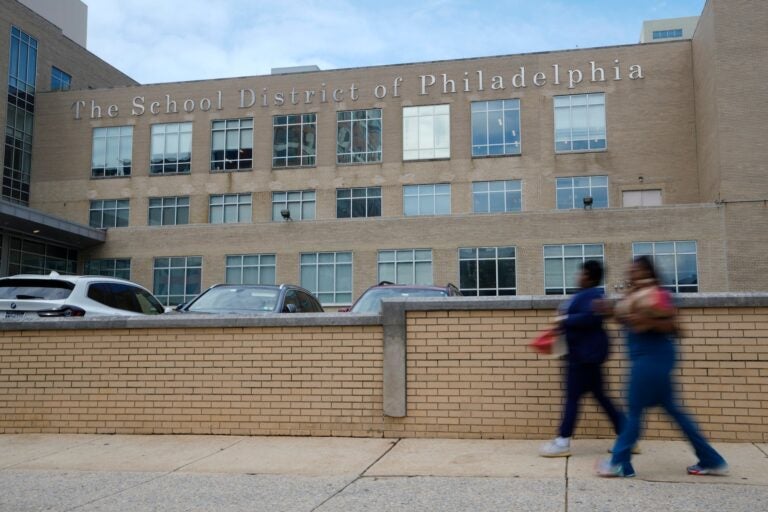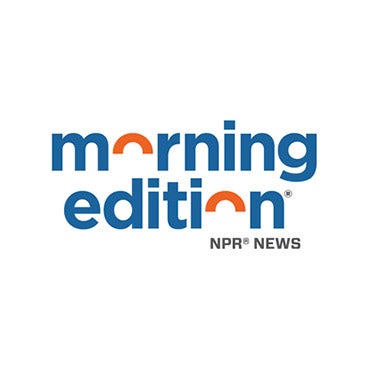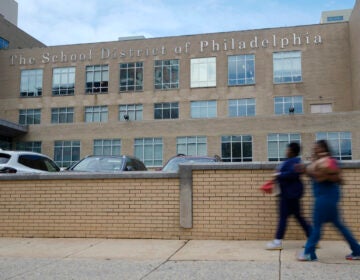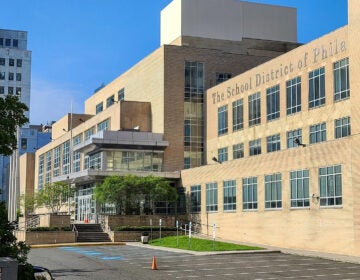The School District of Philadelphia’s Facilities Planning Process: What you need to know
The district is moving to rightsize its building stock. Some Philadelphians are concerned about whether their voices will be taken into account.

The School District of Philadelphia headquarters are shown in Philadelphia, Tuesday, July 23, 2024. (AP Photo/Matt Rourke)
From Philly and the Pa. suburbs to South Jersey and Delaware, what would you like WHYY News to cover? Let us know!
The School District of Philadelphia is approaching the final stage of its planning process for its buildings and infrastructure, with a preliminary plan expected this fall and a deadline for final decisions set for December 2025.
The fate of over 300 schools hangs in the balance as district staff and consultants deliberate on which schools will receive new investments, and which will close, co-locate or remain the same.
It’s a fraught process for many who remember the pain of the city’s previous Facilities Planning Process, which yielded 30 school closures in 2013. Financial benefits for the district were minimal in the end, displaced students struggled more with suspensions and absences, and academic scores dropped for students at schools that took on displaced students.
The district has emphasized that this time will be different. Officials said they are actively engaging with the community and involving them in the decision making.
“When we get to the end of this process, we want the community to feel like this is an exercise the administration did with them and not to them,” Superintendent Dr. Tony Watlington said at a school board meeting in June.
Still, some Philadelphians involved in district-organized advisory groups have sounded the alarm about the process, arguing that they haven’t had sufficient access to information about the decision-making process or opportunities to actually influence district planning.
July has seen a string of community sessions hosted around the city for residents to learn about the process and voice their thoughts. There will be four more in-person sessions this upcoming week.
Here’s a breakdown of what’s going on with school buildings.
Why is this process happening?
The average age of Philadelphia public school buildings is 73, according to the district. That’s no secret to students and families familiar with schools that suffer from plumbing issues, lack of adequate heating and cooling systems and problems with asbestos exposure.
The district is also underenrolled, with more than 60,000 empty seats across the city. Some schools in the northeast and south significantly overenrolled, and many others throughout the city are operating below building capacity. The district says its goal is to more efficiently allocate resources to each student. Some community members and experts have expressed doubt that school closures can actually lead to that outcome.
A host of factors have played into enrollment levels. The proliferation of charter schools and gentrification in historically Black neighborhoods have contributed to dip in class sizes. In contrast, there are neighborhoods that have an influx of immigrant fa milies boosting enrollment. In 2024, district enrollment rose for the first time in 10 years, but it’s still at much lower levels than the early 2000s.
What are the decision-making criteria for keeping, shutting down or upgrading buildings?
Watlington and staff members will present a plan for the Board of Education to review. Each school will be sorted into one of five potential outcomes: maintain, modernize, co-locate, repurpose or close.
Those recommendations will be made, in part, based on schools’ placements in four different data categories.
- School building score: reflects the overall condition of the physical space
- Program alignment score: measures how well the building supports the arts, career technical education, pre-K, physical education, special education and special courses
- Capacity/utilization score: shows a school’s enrollment level relative to its capacity
- Neighborhood vulnerability score: uses the Center for Disease Control and Prevention’s social vulnerability index to account for socioeconomic conditions.
Watlington said he aims to decrease the number of varied grade bands across the district with a focus on moving away from traditional middle schools, of which the district only operates 14, in favor of K-8 schools. He cited research suggesting that students perform better with fewer school transitions.
What’s the timeline?
A 30-person project team, which includes community, nonprofit and government leaders, met monthly from the beginning of the year through June along with multiple advisory groups that include community partners, elected officials, union representatives, parents and guardians, community leaders, school leaders, school support staff, teachers and students.
The district is finishing up a total of 16 community update sessions, all in the month of July. Other community conversations and listening sessions were hosted throughout fall and winter earlier in the year.
A draft plan is set to be released in August, with another round of community update sessions for people to provide feedback. Then, an updated plan will be presented to the Board of Education in November. A final plan will need to be approved before the end of the year.
In April, the district was set to release a comprehensive data website with more granular information about schools. But that release was pushed back and still hasn’t come to pass. A school district representative told WHYY News the data was still being reviewed, and “will be posted as soon as the review process is complete.”
Advisory group concerns
Some members of the district’s multiple advisory groups have expressed urgent concerns with the process, speaking with news outlets and at board meetings to raise the alarm. They reported that meetings were largely filled with lectures and powerpoints, with little opportunity for discussion — and that many questions they raised went unanswered.
Akira Drake Rodriguez, a University of Pennsylvania professor whose research deals with race, cities and space, participated in the community partners advisory group.
“A lot of the information was redundant,” Rodriguez said. She added that her group’s questions about the data behind decision making were never answered and that their arguments against any school closures did not seem to move the needle.
After the first few meetings, she said, her group’s attendance “dropped significantly.”
Rodriguez and other advisory group members formed an independent coalition to connect outside of the standard meetings, called Stand Up for Philly Schools, or SUPS.
Edwin Mayorga is a member of the parent and guardian advisory group. Getting involved in SUPS, he said, “kind of confirmed that I was not crazy in feeling weird about the whole situation,” he said. “There was something to be concerned about.”
Mayorga, who is one of just a couple Spanish speakers in his advisory group, said a lack of engagement in English-learning immigrant communities was one issue that stood out to him.
Rodriguez is against shuttering any schools. She researched the importance of neighborhood public schools as a community anchor and pointed out that multiple studies suggest closing schools rarely yields the savings or academic improvements desired by the district.
How far does listening go?
At the community update session in Andrew Hamilton Elementary School in Cobbs Creek on Thursday, attendees doubted that every school in the area was represented, even though it was one of the most well-attended sessions this summer. At one of the tables there was only one parent whose child attended any of 15 schools being discussed.
That so many meetings are taking place in the middle of summer, when parents and students may be less likely to show up, was one concern that was shared by one of the groups. A district official pointed out that another batch of engagement sessions would take place in the fall after the release of a draft plan.
A district staff member explained the four data categories to community members and plotted each school in a learning network on a large sheet of paper, where the x-axis denoted neighborhood vulnerability and the y-axis capacity/utilization score.
“What do you all observe about this learning network?” she asked.
Attendees pointed out that many schools had a high level of vulnerability with a low utilization score. Closures hung heavy over the conversation — no one moved to suggest any. Some considered the merits of co-locating two schools that were close to each other.
At one of the participating tables, community members discussed how gentrification in West Philadelphia could have contributed to lower enrollment, as well as a lack of district investment leaving neighborhood schools less desirable to families over the years.
Concerns surfaced about what would happen to teachers and staff in the case of a closure, and how students would navigate transportation if a nearby building shut down and the other available school was farther away. Grade bands were another topic. Several attendees disagreed with the district’s mission to phase out middle schools in favor of K-8 schools.
“We need more data,” one attendee, a mother, said, explaining that the lack of context behind each school’s ranking across the four categories meant there was less feedback she could give.
Visiting the table, Deputy Superintendent for Operations Oz Hill said that he would take that feedback into consideration and try to provide more of the detailed data that the district has on each school in the next round of engagement sessions.
“I’m glad they’re trying to do more and that they’re having sessions across the city. I thought the small group format really let us talk to somebody,” said Katy Egan, an organizer with Philly DSA, the Philadelphia chapter of the Democratic Socialists of America.
Egan worked as a teacher at the Samuel B. Huey school before it was closed in 2013 and converted to a charter school. She said that the process was crushing.
“The teachers that I worked with were really dedicated. They worked really hard. They wanted good things for their students,” Egan said. “And I feel like the school district was like, you guys failed.”
She said she attended previous rounds of update sessions in the fall that were moderated by consultants and appreciated that district officials ran them this time around. Still, she’s worried about whether the meetings will shape the outcome.
“I do feel like, and I said this at the meeting, that it was … set up in such a way to get us to co-sign and agree to school closures,” Egan said.
Hill said he is aware of the concerns.
“I understand completely the apprehension, the distrust and I might even call it the scar tissue that remains from the previous attempts to address our facilities,” Hill said. “Our greatest challenge existed in community engagement.”
Hill said he hoped the process would fulfill the district’s mission to create more equitable academic outcomes across the city and that some closures would be unavoidable.
“Quite frankly, with the limited resources that we have, there are some schools that are underenrolled, and that are not meeting the needs of students, that probably are gonna close,” he said. “We know that …The hope is that if we get to those schools that are closed, that community members will say ‘I understand that there was a process to get there, I understand that my voice was heard, and I understand all of the support that will be provided to help me make the decision about what I do.’”

Get daily updates from WHYY News!
WHYY is your source for fact-based, in-depth journalism and information. As a nonprofit organization, we rely on financial support from readers like you. Please give today.







